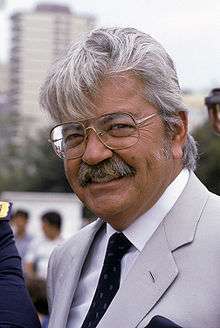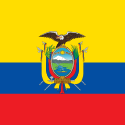León Febres Cordero
| León Febres-Cordero | |
|---|---|
 | |
| 35th President of Ecuador | |
|
In office August 10, 1984 – August 10, 1988 | |
| Vice President | Blasco Peñaherrera Padilla |
| Preceded by | Osvaldo Hurtado Larrea |
| Succeeded by | Rodrigo Borja |
| Mayor of Guayaquil | |
|
In office August 10, 1992 – August 10, 2000 | |
| Deputy | Luis Chiriboga |
| Preceded by | Harry Soria Lamán |
| Succeeded by | Jaime Nebot |
| Personal details | |
| Born |
León Esteban Francisco Febres-Cordero Ribadeneyra March 9, 1931 Guayaquil, Guayas, Ecuador |
| Died |
December 15, 2008 (aged 77) Guayaquil, Guayas, Ecuador |
| Cause of death | Lung cancer |
| Resting place | Parques de la Paz, La Aurora, Guayas, Ecuador |
| Nationality | Ecuadorian |
| Political party | Social Christian Party |
| Spouse(s) |
Cruz María Massuh (m. 1988) |
| Alma mater | Stevens Institute of Technology |
| Signature |
|
León Esteban Febres-Cordero Ribadeneyra (March 9, 1931 – December 15, 2008), known in the Ecuadorian media as LFC or more simply by his composed surname (Febres-Cordero), was the 35th President of Ecuador, serving a four-year term from August 10, 1984 to August 10, 1988. During his Presidency he sought to introduce market-oriented reforms, and also led a security crackdown on a guerrilla group, ¡Alfaro Vive, Carajo!.[1][2]
Early life
Febres-Cordero was born to a well-to-do Guayaquil family on March 9, 1931. His father sent him to study in the United States, where he first attended Charlotte Hall Military Academy in Maryland, then Mercersburg Academy in Pennsylvania for high school, and then graduated as an engineer from the Stevens Institute of Technology in Hoboken, New Jersey (which he visited after being elected in 1984).[3][4]
Upon his return to Guayaquil, Febres-Cordero entered business, dealing variously in paper, electrical parts, chemicals and textiles. Eventually he became an executive in the Noboa Group, a large agribusiness.[3]
Career
Presidency (1984–1988)
The Febres Cordero government promoted a conservative economic policy. While some praised Febres Cordero's economic policies, they became largely unpopular with most Ecuadorians. Several of his ministers were accused of corruption. His Finance Minister (and future Vice President), Alberto Dahik, was impeached by Congress.[5]
Febres Cordero, a close ally of US President Ronald Reagan, was sharply criticized for an increase in human rights violations, including torture and extrajudicial killings.[6] Decades later, Rafael Correa established a Truth Commission to investigate human rights violations, particularly those that occurred during Febres Cordero's administration.
In 1987 Febres Cordero was kidnapped for 11 hours[7] by members of the air force demanding the freedom of General Frank Vargas Pazzos, who had been imprisoned after leading two uprisings in March 1986, aimed at toppling the Minister of Defense. Congress approved a resolution granting Vargas amnesty, but Febres Cordero refused to publish the resolution, thus denying it the force of law. It was only after his January 1987 kidnapping that he signed the amnesty and released Vargas.[5]
Post-Presidency
Later he became the mayor of Guayaquil for two terms (1992–2000)[8] His time as mayor is widely considered successful (compared to his troubled presidency) as he lifted the city from the disastrous state in which it was left after years of mismanagement, corruption and clientelistic practices by the populist Bucaram family (particularly the administrations of Abdalá and his sister Elsa). Febres-Cordero ordered the administration and finances and carried out massive public works, thus cementing a base for his dauphin, Jaime Nebot (also of the PSC) who turned out to be the main political rival of President Correa (2007-2017), establishing a reputation as an important force in Ecuadorean politics.[9]
In 2002 he ran successfully for a seat in Congress, representing his native province in the 2003-2007 period. Despite recurrent absentism produced by health constraints, he was reelected in 2006; but those same issues forced him to retire shortly before the beginning of the new legislative period (and also of rival Correa’s tenure) in early 2007, symbolically marking the end of his political clout over the country.[10][11]
Personal life
Febres-Cordero was first married to former First Lady of Ecuador María Eugenia Cordovez, and they had four daughters – María Eugenia, María Fernanda, María Liliana and María Auxiliadora.[3][8] They divorced in 1988 after thirty-four years of marriage.[12] Later he married Cruz Maria Massu, but they had no children.[8]
Death
A smoker, he died aged 77 in Guayaquil, on Monday, December 15, 2008 at 4:30 pm, of lung cancer and emphysema.[8] He was granted a state funeral. His remains were buried at the Cementerio Parque de la Paz.
References
- ↑ New York Times, 16 November 2008, Febres Cordero, giant of Ecuador politics, is dead
- ↑ "Leon Febres Cordero". The Daily Telegraph. 16 December 2008.
- 1 2 3 Riding, Alan (1984) "Man in the News: Entrepreneur for Ecuador: Leon Febres Cordero Rivadeneira" The New York Times 9 May 1984, page A-10, col. 3
- ↑ https://www.youtube.com/watch?v=jYi3xl8i_vs
- 1 2 CRISIS IN ECUADOR: DEMOCRACY IS LOSER. New York Times, 28 January 1987
- ↑ New York Times, 13 March 1988, Report Finds Ecuador Rights Abuses Rose Sharply
- ↑ El Mundo, 16 December 2008, León Febres Cordero, ex presidente de Ecuador
- 1 2 3 4 Solano, Gonzalo (2008), The Miami Herald, 15 December 2008, from the Associated Press, "Former Ecuadorean President Febres Cordero dies"
- ↑ https://www.independent.co.uk/news/obituaries/leon-febres-cordero-confrontational-president-of-ecuador-1192737.html
- ↑ <Ibid.
- ↑ mobile.ecuadorinmediato.com/index.php?module=Noticias&func=news_user_view&id=46708 in Spanish
- ↑ "Fallece ex primera dama Eugenia Cordovéz, primera esposa de León Febres Cordero". Ecuador En Vivo. 30 September 2012. Archived from the original on 9 January 2013. Retrieved 17 October 2012.
External links
| Wikimedia Commons has media related to León Febres-Cordero Ribadeneyra. |
- Conmemorial video
- Official Website of the Ecuadorian Government about the country President's History
- Edufuturo
- Amnesty International
| Political offices | ||
|---|---|---|
| Preceded by Osvaldo Hurtado Larrea |
35th President of Ecuador August 10, 1984–August 10, 1988 |
Succeeded by Rodrigo Borja |
